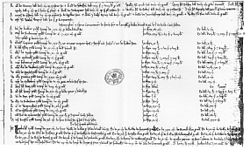Great Roll of the Exchequer
| Pipe rolls | |
|---|---|

Pipe roll page from the 1194 roll
|
|
| Date | 1130–1833 |
| Provenance | English Exchequer |
| Series | Pipe rolls |
| Genre | Accounting documents |
| Subject | Records of the audits of the English Exchequer |
| Period covered | 1130–1833 |
The Pipe rolls, sometimes called the Great rolls, or the Great Rolls of the Pipe, are a collection of financial records maintained by the English Exchequer, or Treasury, and its successors. The earliest date from the 12th century, and the series extends, mostly complete, from then until 1833. They form the oldest continuous series of records concerning English governance kept by the English, British and United Kingdom governments, covering a span of about 700 years. The early medieval ones are especially useful for historical study, as they are some of the earliest financial records available from the Middle Ages. A similar set of records was developed for Normandy, which was ruled by the English kings from 1066 to 1205, but the Norman Pipe rolls have not survived in a continuous series like the English.
They were the records of the yearly audits performed by the Exchequer of the accounts and payments presented to the Treasury by the sheriffs and other royal officials; and owed their name to the shape they took, as the various sheets were affixed to each other and then rolled into a tight roll, resembling a pipe, for storage. They record not only payments made to the government, but debts owed to the crown and disbursements made by royal officials. Although they recorded much of the royal income, they did not record all types of income, nor did they record all expenditures, so they are not strictly speaking a budget. The Pipe Roll Society, formed in 1883, has published the Pipe rolls up until 1224.
The Pipe rolls are named after the "pipe" shape formed by the rolled up parchments on which the records were originally written. There is no evidence to support the theory that they were named pipes for the fact that they "piped" the money into the Treasury, nor for the claim that they got their name from resembling a wine cask, or pipe of wine. They were occasionally referred to as the roll of the treasury, or the great roll of accounts, and the great roll of the pipe.
The Pipe rolls are the records of the audits of the sheriffs' accounts, usually conducted at Michaelmas by the Exchequer, or English treasury. Until the chancery records began in the reign of King John of England, they were the only continuous set of records kept by the English government. They are not a complete record of government and royal finances, however, as they do not record all sources of income, only the accounts of the sheriffs and a few other sources of income. Some of the payments that did not regularly fall under the Exchequer were occasionally recorded in a Pipe roll. Neither do the Pipe rolls record all payments made by the exchequer. They were not created as a budget, nor were they strictly speaking records of receipts, but rather they are records of the audit of the accounts rendered. Although the rolls use an accounting system, it is not one that would be familiar to modern accountants; for instance until the end of the 12th century, no record was made of the total amount taken in by the sheriff of each shire. In their early form, they record all debts owed to the Crown, whether from feudal dues or from other sources. Because many debts to the king were allowed to be paid off in installments, it is necessary to search more than one set of rolls for a complete history of a debt. If a debt was not paid off completely in one year, the remainder of the amount owed was transferred to the next year. They did not record the full amount of debts incurred in previous years, only what was paid that year and what was still owed. Besides the sheriffs, others who submitted accounts for the audit included some bailiffs of various honours, town officials, and the custodians of ecclesiastical and feudal estates.
...
Wikipedia
